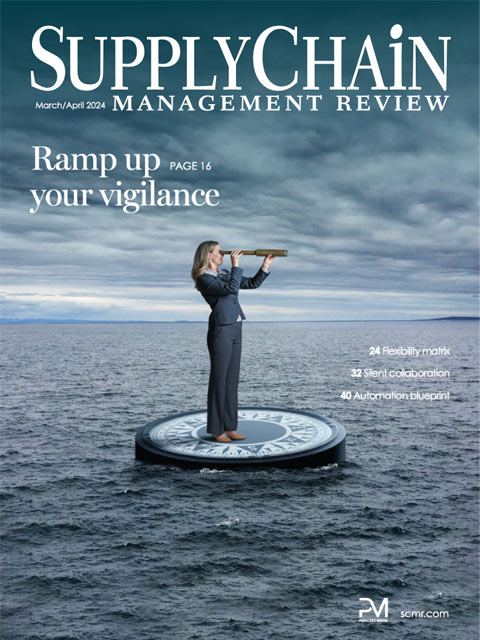Sorry, but your login has failed. Please recheck your login information and resubmit. If your subscription has expired, renew here.
March-April 2024
Part of any supply chain manager’s job is risk mitigation. Thanks to COVID-19 and the ensuing, and constant, disruptions that have followed, more companies are now focused on reducing their exposure to supply chain chaos. We’ve heard a lot about diversification in recent years—having multiple suppliers in multiple locations. But risk mitigation goes far beyond diversification, and the recent case of Boeing should serve as a cautionary tale not to avoid those other risks. Browse this issue archive.Need Help? Contact customer service 847-559-7581 More options
Digital systems that enhance supply chain visibility up and down are among the most important investments companies make today. Real-time visibility of inventory, capacity, supply, and demand conditions is central to agile supply chain operations in dynamic environments. However, even excellent visibility may not be sufficient to adapt supply chains in time for more fundamental shifts. Most businesses encounter intensifying geopolitical tensions, revolutionary advances in artificial intelligence and automation, pressing environmental sustainability concerns, and growing societal pressures to foster diversity and inclusion. This means that supply chains increasingly need organizational vigilance in addition to better visibility. This article describes what supply chain vigilance is about, why supply chain executives and managers need to embrace it, and how to create a vigilant organization able to manage increasing external uncertainty.
Introduction
Supply chain visibility has become a key strategic priority for operational managers and executives alike. Gartner Research reported it as the most funded supply chain initiative in 2019, the year before the COVID-19 pandemic made companies even more jarringly aware of its criticality. Its importance has repeatedly been emphasized since then by surprise events such as the Suez Canal’s week-long blockage due to the grounding of containership Ever Given, business disruptions from China’s zero-COVID policy, and costlier ocean shipping with longer lead times around the Cape of Good Hope to avoid Houthi attacks in the Red Sea. In a 2022 McKinsey survey titled “Taking the Pulse of Shifting Supply Chains,” 67% of respondents reported that their companies had invested in dashboard technologies to enhance supply chain visibility. A more recent 2023 survey of 2,000 companies in 15 countries conducted by the Capgemini Research Institute showed that investing in supply chain visibility and diversification was the number one strategic priority for companies, ahead of technology and sustainability.
SC
MR
Sorry, but your login has failed. Please recheck your login information and resubmit. If your subscription has expired, renew here.
March-April 2024
Part of any supply chain manager’s job is risk mitigation. Thanks to COVID-19 and the ensuing, and constant, disruptions that have followed, more companies are now focused on reducing their exposure to supply chain… Browse this issue archive. Access your online digital edition. Download a PDF file of the March-April 2024 issue.Digital systems that enhance supply chain visibility up and down are among the most important investments companies make today. Real-time visibility of inventory, capacity, supply, and demand conditions is central to agile supply chain operations in dynamic environments. However, even excellent visibility may not be sufficient to adapt supply chains in time for more fundamental shifts. Most businesses encounter intensifying geopolitical tensions, revolutionary advances in artificial intelligence and automation, pressing environmental sustainability concerns, and growing societal pressures to foster diversity and inclusion. This means that supply chains increasingly need organizational vigilance in addition to better visibility. This article describes what supply chain vigilance is about, why supply chain executives and managers need to embrace it, and how to create a vigilant organization able to manage increasing external uncertainty.
Introduction
Supply chain visibility has become a key strategic priority for operational managers and executives alike. Gartner Research reported it as the most funded supply chain initiative in 2019, the year before the COVID-19 pandemic made companies even more jarringly aware of its criticality. Its importance has repeatedly been emphasized since then by surprise events such as the Suez Canal’s week-long blockage due to the grounding of containership Ever Given, business disruptions from China’s zero-COVID policy, and costlier ocean shipping with longer lead times around the Cape of Good Hope to avoid Houthi attacks in the Red Sea. In a 2022 McKinsey survey titled “Taking the Pulse of Shifting Supply Chains,” 67% of respondents reported that their companies had invested in dashboard technologies to enhance supply chain visibility. A more recent 2023 survey of 2,000 companies in 15 countries conducted by the Capgemini Research Institute showed that investing in supply chain visibility and diversification was the number one strategic priority for companies, ahead of technology and sustainability.
SC
MR


Latest Supply Chain News
Latest Podcast

 Explore
Explore
Business Management News
- Strengthening customer fulfillment: Building a strategic stakeholder network
- The hard job of teaching soft skills
- Trump picks former Wisconsin congressman Sean Duffy for DOT secretary
- Made in Mexico, manufactured by China
- Retail sales see gains in October, reports Commerce and NRF
- Balancing green and speed: Home delivery insights from the pandemic era
- More Business Management
Latest Business Management Resources

Subscribe

Supply Chain Management Review delivers the best industry content.

Editors’ Picks






 Download Article PDF
Download Article PDF